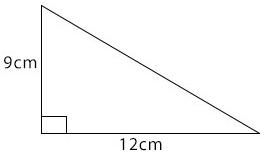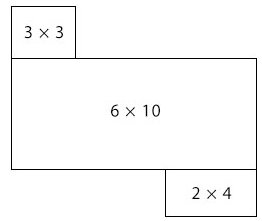
Diameter = 2r, where r= radius
Example:
Solution:
Area of a circle = πr2
227×(312)2=227×72×72=11×72=772m2=38.5m2
Solution:
Area of circle = πr2
126.5cm2=227r22532=227r2253×7=22×2×r2r2=1614r=1614−−−√r=12.6892r=6.345r=6.35(2d.p.)
Area of a Triangle
Any diagonal of a rectangle divided it into two equal right- angled triangles forms a right angled triangle.
Thus:
Area of a right – angled triangle
= ½ × product of sides containing the right angle.
Area of triangle = ½ × base × height.
Example:
Calculate the area of the triangle shown below

The two sides containing the right angle measure 9 cm and 12cm.
Area of triangle = ½ × 9cm × 12cm
= 54cm2

Solution:
Area of triangle = ½ × base × height
20cm2 = ½ × 8cm × h
20cm2 = 4hcm
h = 20cm2/4cm
h = 5cm.
Therefore, height of the triangle = 5 cm.
CLASS ACTIVITY
Area of a Square
A square is a shape whose length and breadth are equal
Area of a square = l2 = (length of side)2
Therefore, length of side = area of square−−−−−−−−−−−√

Solution:
Area of triangle = ½ × base × height
20cm2 = ½ × 8cm × h
20cm2 = 4hcm
h = 20cm2/4cm
h = 5cm.
Therefore, height of the triangle = 5 cm.
CLASS ACTIVITY
Area of a Square
A square is a shape whose length and breadth are equal
Area of a square = l2 = (length of side)2
Therefore, length of side = area of square−−−−−−−−−−−√
Examples:
Solution:
Formula for area of a square = l2
= 5cm × 5cm
= 25cm2
Solution:
Length of side = area of square−−−−−−−−−−−√=100m2−−−−−√=10m
Area of a Rectangle
A rectangle 5cm long by 3cm broad can be divided into squares of side 1cm as shown below.

By counting, the area of the rectangle = 15cm2.
Notice also that 5 × 3 = 15. Thus in general;
Area of rectangle = length × breadth.
Also notice that 5 = 15 ÷ 3 and 3 = 15 ÷ 5
Hence,
Length of rectangle = area ÷ breadth
Breadth of rectangle = area ÷ length
Examples:
Solution:
Area of a rectangle = length × breadth
= 6cm × 3.5cm
= 21 cm
Solution:
Breadth = arealength=22416cm=14cm
Area of a Parallelogram

The area of the parallelogram, P = area of rectangle, R
= b×h
In the diagram above, the height of the parallelogram is h and its base is b.
In general,
Area of parallelogram = base × height
Base of parallelogram = area ÷ height
Height of parallelogram = area × base
Area of a Trapezium

ABCD is a trapezium in which AB is parallel to DC. The diagonal AD divides the trapezium into two triangles. The height, h, is the same for both triangles.
area of trapezium ABCD
= area of Δ ABD + area of Δ BDC
= ½ AB × h + ½ DC × h
= ½ (AB + DC)h
Example:
Calculate the area of the trapezium ABCD in figure below

The diagonal AC divides the trapezium into two triangles. The height of each triangle is 8 cm.
Area of Δ ACB = ½ × 13cm × 8cm =52cm2
Area of Δ ACD = ½ × 6cm × 8cm = 24cm2
Area of trapezium = 52cm2 + 24cm2 = 76cm2
CLASS ACTIVITY
1. Copy and complete the tables of rectangles below


Area of Irregular Shapes
Example:

Solution:
The shape can be split into a 3 × 3 square and 6 × 10 and 2 × 4 rectangles.

Area = area of square + area of the 2 rectangles = (3 × 3 +6 × 10 + 2 × 4 )m2
= (9 + 60 + 8)m2
= 77 m2
PRACTICE EXERCISES
ASSIGNMENT
Read our disclaimer.
AD: Take Free online baptism course: Preachi.com 